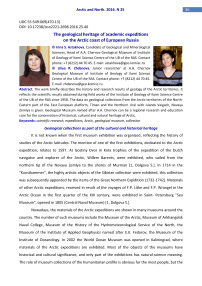The geological heritage of academic expeditions on the Arctic coast of European Russia
Автор: Irina S. Astakhova, Liliya R. Zhdanova
Журнал: Arctic and North @arctic-and-north
Рубрика: Economics, political science, society and culture
Статья в выпуске: 25, 2016 года.
Бесплатный доступ
The work briefly describes the history and research results of geology of the Arctic territories. It reflects the scientific results obtained during field works of the Institute of Geology of Komi Science Centre of the UB of the RAS since 1958. The data on geological collections from the Arctic territories of the North- Eastern part of the East European platform, Timan and the Northern Ural with islands Vaigach, Novaya Zemlya is given. Geological Museum named after A.A. Chernov can be a regional research and education core for the conservation of historical, cultural and natural heritage of Arctic.
Scientific research, expeditions, Arctic, geological museum, collection
Короткий адрес: https://sciup.org/148318617
IDR: 148318617 | УДК: 55:549:069(470.13) | DOI: 10.17238/issn2221-2698.2016.25.40
Текст научной статьи The geological heritage of academic expeditions on the Arctic coast of European Russia
Geological collections as part of the cultural and historical heritage
It is not known when the first museum exhibition was organized, reflecting the history of studies of the Arctic latitudes. The mention of one of the first exhibitions, dedicated to the Arctic expedition, relates to 1597. At Gostiny Dvor in Kola trophies of the expedition of the Dutch navigator and explorer of the Arctic, Willem Barents, were exhibited, who sailed from the northern tip of the Novaya Zemlya to the shores of Murman [1, Dolgova S.]. In 1714 in the "Kunstkammer", the highly artistic objects of the Sibirian collection were exhibited, this collection was subsequently appended by the items of the Great Northern Expidition (1732-1742). Materials of other Arctic expeditions, received in result of the voyages of F.P. Litke and F.P. Wrangel in the Arctic Ocean in the first quarter of the XIX century, were exhibited in Saint- Petersburg "Sea Museum", opened in 1805 (Central Naval Museum) [1, Dolgova S.].
Nowadays, the materials of the Arctic expeditions are shown in many museums around the country. The number of such museums include the Museum of the Arctic, Museum of Arkhangelsk Naval College, Museum of the History of the Hydrometeorological Service of the North, the Museum of the Institute of Applied Geophysics named after E.K. Fedorov, the Museum of the Institute of Oceanology. In 2002 the World Ocean Museum was opened in Kaliningrad, where materials of the Arctic expeditions are exhibited. Most of the objects of the museums have historical and cultural significance, and only part of the exhibitions has natural-science meaning. The role of museum collections of the humanitarian profile is obvious for the most people, but the natural sciences, particularly geological collections are not widely accepted as an important part of the historical and cultural heritage.
Geological sample information has multiple informative facets and multifunctionality. Unlimitedness of the process of obtaining information from geological samples appears brighter. In the first place, the object for study is substance. However, geological sample as a museum item has not only specific scientific information, but also details of the historical and cultural character. Samples, and in particular collections, specially selected and connected by ideological basis and thematic, can be considered as evidence of a certain stage of development of scientific views of a single scientist or the whole trend, as witnesses of the cultural and historical events and major geographical discoveries. Thus, a museum geological sample should be considered not only as a natural formation, but also as a subject closely related to the history of science.
In Russia, there are not so many museums, where geological collections of the Arctic territories can be widely presented. One of these museums is the Scientific and Geological Museum named after Alexander Alexandrovich Chernov. The museum was founded in 1969 as a scientific structural unit of the Institute of Geology of the Komi Science Center of the Ural Branch of the Russian Academy of Sciences (KSC UB RAS), located in Syktyvkar. The museum has gained an extensive geological material, reflecting current knowledge about the composition, structure and history of the Earth's crust in the north-east of the European part of Russia: Timan, Northern, Subpolar and Polar Ural, the Pai-Khoi, Vaigach Island and Novaya Zemlya. Geological collections are the real result of conducted research and scientific expeditions.
Arctic collections of the Museum are presented by rocks, minerals, organic debris, core material collected from the Northern Timan and tundra, from the islands of Novaya Zemlya and Vaigach, from the Kanin and Yugor Peninsulas. This geological assembly consists of 122 collections: 70 collections are monographic, 11 belong to the category of exhibitional and 21 collections are working collections with total volume of 13,700 units.
Academic geological expeditions in the Arctic before the beginning of XX century
Historically, in the Arctic exploration, many years of experience of the Academy of Sciences in the organization and research of the Arctic territory can be seen clearly. The defining role of the Academy in the choice of the area and subjects of works with government requests is fully described for regions of the European North [2, Askhabov A.M., Getsen M.V., Samarin A.V.].
Soon after the establishment of the Imperial Academy of Sciences in St. Petersburg, the studying of the vast northern territories and the first Arctic expeditions started. The first information about the geology of the area were obtained during research expeditions in 1907-
1912, arranged by the Arctic explorer V.A. Rusanov, who reconstructed paleo-environment between the Arctic Ocean and the disappeared sea of the Central Europe, and the ways of settlement of some species of fauna in the polar regions, and who also opened deposits of coal at Svalbard. Expedition and stationary research made significant contribution to the study of the Arctic, hich were organized by the Polar Commission (1914), which had the task to prepare physiographic and administrative maps of the North [3, Roschevsky M.P., Roschevskaya M.P., Brovina A.A.] The heyday of the Commission's activities took place in the 1920s — early 1930s.
The difficult economic and political situation in the country with the absence of its own raw material base became the motive to create the Northern Scientific and Industrial Expedition (1920). This expedition was instructed to carry out research and field work, as well as to coordinate any investigations undertaken by other organizations in the whole space from the Northern Ural up to the eastern edge of Taimyr Peninsula and in the Arctic islands of the European part of the USSR [4, Samoylovich R.L.].
In 1920-1930 the expeditions organized by the Institute of Geography, the Russian Academy of Sciences, Institute of Hydrology and mainly by the North scientific expedition led by P.V. Wittenburg, R.L. Samoilovych, M.M. Kruglovskaya, during which the representative material on the morphology of shores and their structures with rich paleontological collections was gained. Collected items of the Silurian and Devonian fauna mainly went to the determination by the leading experts (D. Nalivkin, V. Verrieres, E. Rhine, F. Chernyshev) [5, P.V. Wittenburg].
In 1933, All-Union Arctic Institute organized the expedition led by the mining engineer B.V. Miloradovich and his assistant N.N. Mutafi, the task of this expedition was to find mineral resourses and to arrange the geological survey of the northern coast of Novaya Zemlya. A great contribution was made in the study of magmatic formations of Novaya Zemlya and in the peculiarities of polymetallic mineralization [6, Miloradovich B.V.].
In 1933 Pechora team trip was arranged under the leadership of A.P. Karpinski, and in the same year there was a brigade trip of the Polar Commission to the island Vaigach [3]. As a result of large-scale works of Pechora expedition, the working hypothesis of the national economic development of the Pechora region was adopted at the Presidium of the USSR Academy of Sciences. Government regulations developed on the basis of this hypothesis have defined the development strategy of the Pechora region. One of the main proposals of the academic team was the construction of the railway to Vorkuta.
By this time, field studies were made by Professor A.A. Chernov, who already in 1929 was engaged in stratigraphy and tectonics of the coal area of the Pechora region. His mutual with A.F.
Lebedev report in January 1929 at the member of the board of USPD G. Bokia, became the basis for sending Ukhta expedition of USPD. During the expedition to Vorkuta river in 1930, A.A. Chernov discovered Vorkuta coal deposit.
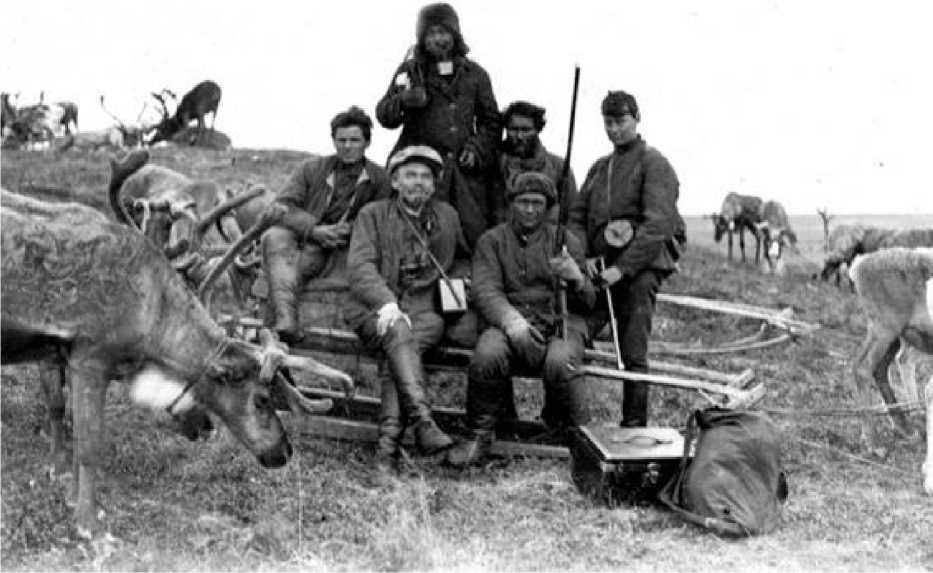
Figure 1. Expedition of A.A.Chernov to river M.Talata. 1933 (from holdings of Museam named after A.A.Chernov)
In April 1931, making a report in Arkhangelsk at the second Conference on Study of Productive Forces of the Northern territory, the scientist said: "The fact that the Pechora coal basin continues to the north, that it goes under the drifts of Bolshezemelskaya tundra, for me it was quite clear already in 1924 ". And in January 1933, speaking at the meeting of the natural resources sector of Gosplan, A.A Chernov said: "Assuming Vorkuta series as continuation of Kozhim, Inta series, and so on, I sent expedition to Vorkuta quite deliberately" [7, Astakhov I., Ievlev A., Zhdanova L.].
The next stage of studying the richest natural resources of the Arctic was connected with the organization of stationary institutions of the Academy of Sciences at the European North. One of the first in the USSR Kola base of the Academy of Sciences of the USSR in Kirovsk (1932) and the North base of the Academy of Sciences in Arkhangelsk (1936) were established. At the beginning of the war, they were evacuated in Syktyvkar, where they began a large-scale scientific study of the region. Research made in 1941-1944 had a significant impact on the economic development of the Komi Republic. As a result, the Presidium of the USSR Academy of Sciences decided to organize in Syktyvkar the Base of USSR Academy of Sciences in the Komi Republic (1944), with the tasks to study natural wealth of the North.
As a result of activities of scientists-geologists a considerable scientific heritage has been left: a vast library on polar issues, cartographic materials, material evidence of expeditions, manuscripts of articles and diaries. The geological materials collected during the Arctic expeditions of the XIX — the beginning of the XX centuries, have been preserved in singular collections of the central natural science museums (CGR Museum named after academician F.N Chernyshev (St. Petersburg), Mining Museum (St. Petersburg).).
Arctic expeditions of the Institute of Geology, Komi Scientific Center, Academy of Sciences of UB of RAS
Research of the northern territories have been raised to a new level with the organization of base of the USSR AS (1944) in Syktyvkar — Komi Branch of the USSR AS (from 1949) - Komi Scientific Center, Ural Branch of RAN (since 1991). During the war and the early postwar years in the Arctic areas of European northeast research was conducted in small volumes. In the Arctic, works were carried out from the southern borders of the forest-tundra zone and up to the islands of Novaya Zemlya and Vaigach. Mainly geological research focused on prospecting and exploration of mineral resources.
In 1958 the Institute of Geology of Komi Branch of the USSR AS was founded, in which the main object of study is the European North-East of Russia, which covers the Arctic in the northeastern part of the East European platform, Timan Ridge and the northern part of the Ural fold system with continuing the island chain (Vaigach, Novaya Zemlya). The expedition studies provided new data on the geological structure and geological history of the territory, and discovered new deposits and occurrences of mineral resources [8, Fishman M.V.].
First expected major success occurred in broadening the base of hydrocarbon raw materials. 1960-s are characterized by an unprecedented rise of geological research in the field of hydrocarbons and by the first bright discoveries of oil and gas and gas condensate fields (Zapadno-Tebukskoe – in 1959; Usinsk deposit — in 1962; Vuktyl deposit — in 1964).
During the first ten years of existence of the Institute, thanks to the materials obtained, the unified regional scheme of stratigraphy of the Paleozoic and Lower Mesozoic sediments was created, the prospects for further study and expand of the mineral resource base within the Pre-Ural fore deep and Bolshezemelskaya tundra appeared [4, Samoylovich R.L].
Since 1969, under the leadership of N.P Yushkin with B.A. Ostaschenko, V.I. Silaev, A.M. Askhabov, K.P. Yanulov, A.B. Makeyev, P.P. Yuhtanov, A.F. Kunz, a very ambitious program of scientific expeditions to the Pai-Khoi and Vaigach-Yuzhnonovozemelsky anticline has been realized. The trips in 1972-1976 were the most fruitful and productive. In those years sea expeditions were arranged, large-scale stratigraphic, paleontological studies were carried out, ore deposits and occurrences on the island Vaigach and north-western part of the Yugor Peninsula were revealed (Fig. 2).
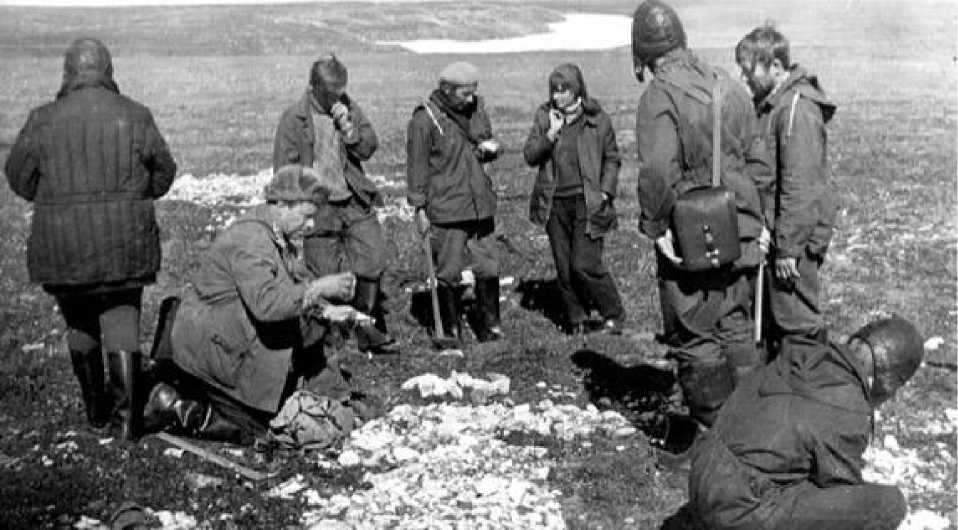
Figure 2. Expedition works by team of the Institute of Geology on Vaigach island, 1973. (from holdings of Museam named after A.A. Chernov)
In 1974, for the first time, in the northern part of the South Island, in the region of Gribov
Bay, Middle Carboniferous deposits were discovered. In 1970s, the new Ural-Novozemelskaya flyuorit province was discovered, with large reserves of the unique quality of raw materials for the optical industry. The complex lithological and geochemical investigations in the north of the Ural-Pakhoi region were arranged, prognostic metallogenic maps were made. By 1976, the fact of the extensive development of fluorite mineralization in the southwestern part of Novaya Zemlya was confirmed, and dozens of new manifestations discovered. Also during these years, complex expeditions were arranged on the coasts of the Barents and Kara Seas, at the North Timan, Yugor
Peninsula, Vaigach Island.
Subsequent expeditions were aimed at deepening the study of the geological structure of the Arctic territories in Pakhoi anticlinorium, Bolshezemelskaya tundra and the northern part of the Timan Ridge. The research on the stratigraphy of upper Cainozoic sediments in oil and gas areas of the Pechora lowland has been continued. The structural and tectonic studies of Pakhoi anticlinorium have been conducted and lithological and geochemical features of the rocks have been studied, fluorite-polymetallic deposits have been tested in detail, and copper and phosphorite mineralizations have been studied.
Geological expeditions in the Nenets Autonomous District, in the Northern Timan have been condacted in order to develop a model of the geological evolution of the Pechora plate. The energetic types of mineral raw materials (oil, gas, coal) have become the objects of attention of the Institute of Geology during recent years. Since 1980s, the stratigraphic, petrographic, mineralogical studies of ore formations of the northern part of the Timan are expanding. The discovery by B.A Guslitser, in 1988 of Harutinskoe deposit located on the river Adzva, became the important event. The remains of extinct mammals and human weapon were found there, and it became the oldest evidence of human emergence in the European North.
The Institute organized 95 geological expeditions to the Arctic territories, including more than 70 teams condacted research on the territory of the Pai-Khoi, Yugor Peninsula and Vaigach island. As a result of longstanding research of the Arctic territories by the members of the Institute of Geology, the extensive materials on the geological structures, ore potential of the Arctic territories have been obtained. The research of Pai-Khoi and Yuzhnonovozemelskaya province have revealed the main geological formations of the territory, new mineral occurrences have been discovered, the general outlook of the mineralogical province has been clarified. Today, the works on intensive study of the mineralization are continuing, in particular, gold and nickel sulphide with concomitant platinum mineralization.
The geological heritage of the Arctic expeditions in the collections of the Geological Museum named after A.A. Chernov
The museum fund, characterizing the geological structure of the Arctic territories, has been formed with samples collected on Kanin Peninsula. The palaeontological collection was arranged in 1958 during the study on the Upper Permian deposits of the northern part of the Russian platform along the rivers B. Krutaya, Nodteyu, Oiva, by team under the leadership of M.A. Plotnikov.
The most detailed studies of Kanin Peninsula were carried out by employees of the Institute in the 70s of the XX century. For the preparation of tectonic and geological map of Timan and Kanin Peninsula, geological teams of the Institute of Geology conducted fieldwork in the central part of the range of Kanin Kamen and south-eastern part of the Pae ridge. The study of tectonics resulted in the collection of petrographic collection of shaly section of of Riphean basement and Phanerozoic platform cover of Kanin Peninsula and the northern Timan. The results of scientific and geological expeditions in 1979-2001 are reflected in the expositions of the museum, which characterize Kanin gabbro-syenite, north Kanin granodiorite-granite complexes and Mikulkinsky complex of granitic pegmatites.
The volume of the geological material consists of more than 2000 items. Complex lithologic and biostratigraphic research of the Upper Permian sediments of the northeast of Cheshskaya Bay has allowed performing lithologic and stratigraphic reconstructions, to extend the taxonomic composition of faunal assemblages. Museum funds have been replenished with samples of the main types of rocks of transitional Ufa-Kazan sediments and with Permian fauna collection. Paleontological collections are different in species diversity, age and representativeness. In 19951996 paleontological collection was replenished with fusulinid from Kanin Peninsula. The most numerous (over 300 samples) collections of flora and fauna are from the coast of the Kara Sea, from the winter shore of the White Sea from the Vendian biota to modern mollusks. A special place in paleontological collection takes the remains of large mammals. The representative collection (26 samples) consisting mainly of ivory, characterizes the development of life more than 1 million years ago (Fig. 3). More than three dozen of monographic and exhibitional collections of the museum with volume of more than 15 thousand samples contain information about the geological structure of Novaya Zemlya. From 1973 to 1976 on the South Island of Novaya Zemlya, Institute researchers conducted comprehensive studies on the stratigraphy, paleontology, tectonics, mineralogy, magmatic of the territory.
Petrological teams (1973, 1974, 1976) conducted a detailed study of the Devonian volcanic rocks (basalts and tuffs) and related manifestations of native copper, widely spread along the southwest coast of the South Island of Novaya Zemlya and on the coast of the Strait of Kostin Shar. The museum exhibition "Petrography" demonstrates geological samples of Kostin Shar magmatic complex represented by basalts and tuffs, dolerite, gabbrodolerite, pikrodolerite and wehrlites.
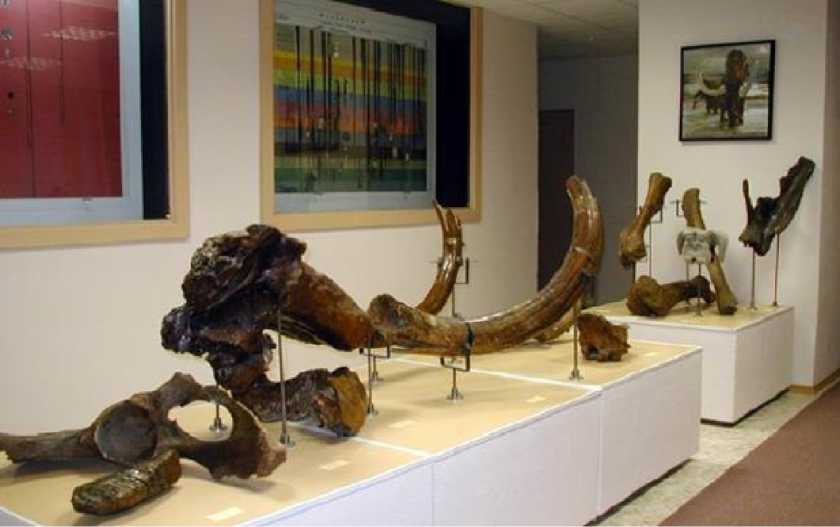
Figure 3. Fossil ivory handed by B. Guslitser (1968) in exhibition of Geological Museam named after A.A. Chernov
In order to isolate a unified regional stratigraphic scale, learning coal and low Permian sediments, a collection of horistits (brachiopods) was stocked in 1974, which is kept in the museum. The rich collections of flora and fauna make it possible to compare the sections of Novaya Zemlya with Pre-Ural fore deep.
In 1979 the museum funds were supplemented by numerous (816 units) collections of plant residues of Permian sediments from the islands of Novaya Zemlya and Mezhdusharsky Island. The study of hundreds of natural sections and drill cores has led to the collection of representative paleontological collections of different groups of fauna and flora. The result of many years of stratigraphic research in Pai-Khoi is a dissection of the sedimentary cover based on the description of the reference sections and monographic description of fossil fauna and flora (Fig. 4).
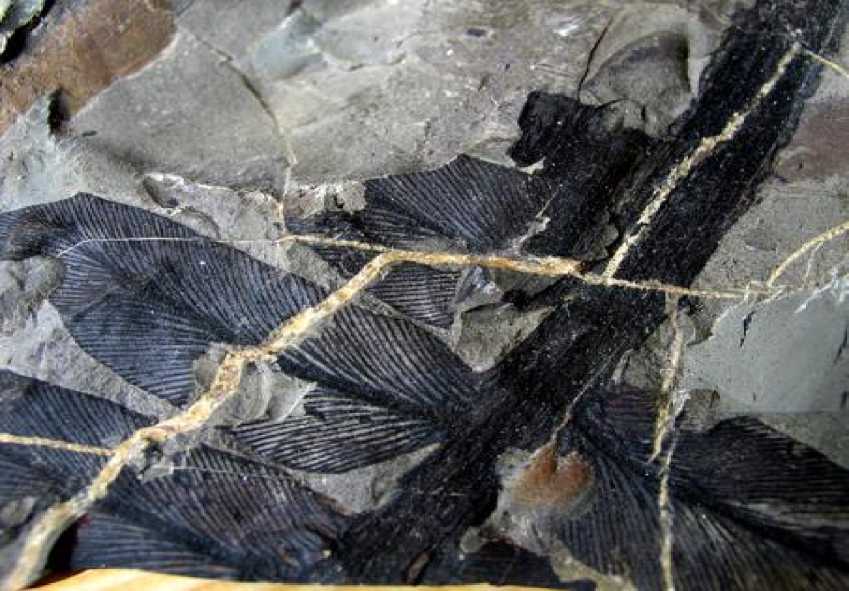
Fugure 4. Imprint of fern Peitaspermum sp. Bolshezemelskaya tundra, river Adjzva (1967).
The collections contain the materials of mineralogical teams (more than 3 thousand samples), which were assembled under the leadership of N.P. Yushkin in 1973 and 1976. [9, Yushkin N.P.]. The materials characterize the ore formations and occurrences of the Central Pai-Khoi and North Pai-Khoi regional zones, the South Islands of Novaya Zemlya and Vaigach island. In 1975, during the expedition on the Yugor Peninsula in the middle reaches of the river Silovayaha the collection of gangue quartz-calcite rocks with mineralization was made. As a result of laboratory tests, arsenic germanium sphalerite was detected, which at that time was the second finding in the world. Later, during the study of these samples, the violet-pink mineral with tarnish was found. In 1983, the new mineral — yushkinit — was approved [10, Makeev A.B., Kovalchuk
N.S.]. Thanks to this discovery, the new geographical name: Yushkinitovoe uschelye has apperead. Mineralogical collection is added by samples of native copper from the South Island of Novaya Zemlya, the Arctic amber from the coast of the Kara Sea, barite, turquoise, rare phosphate minerals (variscite, wavellite, jarosite). The collection of the Arctic territories is supplemented by agate collections (more than 70 samples), collected mainly in 1980-1995 at the Northern Timan in outcrops of the river Belaya.
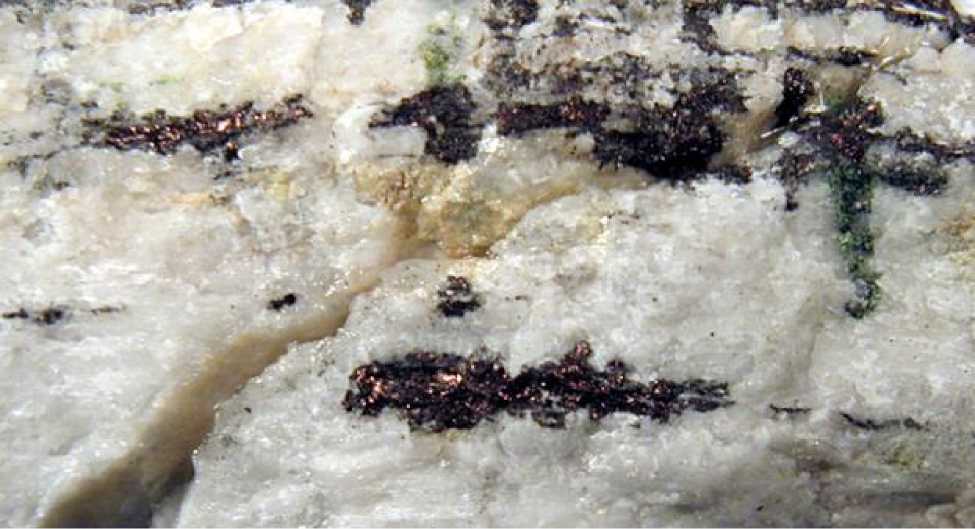
Figure. 5. Yushkinit in quartz reef. Pai-Khoi, Yushkinitovoe uschelye, river Silova-Yakha (1985).
More than 200 samples were handed over by employees of the Institute of Geology after studies of lithological structural features of Pai-Khoi anticlinorium. The largest exhibits from the Arctic territories are wax jasperoids — siliceous rocks, widely developed in the Central Pai-Khoi anticlinoria.
In 2015, the museum funds were replenished by samples of tagamets, suvits and cone fractures from Kara astrobleme — one of the largest impact structures of the Earth, the diameter of which is about 65 kilometers.
The stone material of collections is accompanied by scientific reports, dissertations, monographs, articles, forming a library fund. Due to the accumulated material it is possible to find additional natural science information, and the historical facts of the research of the Arctic territories.
The book fund of the museum has published works of N.I. Timonin "Novaya Zemlya Memorial" (1995). In his book, the author showed that a memorial toponymy of the archipelago is not just a collection of geographical names, but a kind of chronicle of the polar events. In the scientific and popular form N.P. Yushkin in his book "On the islands of the Arctic Ocean" (1979) talked about the history of the study and development of the Arctic Islands, about the harsh nature, about the work and life of scientists.
Conclusion
Today, on the way of education and improvement of society, the development of issues related to the history of science and the problems of nature protection as part of the national heritage is particularly relevant. Unfortunately, the need of the historical education of visitors has not been fully recognized in the departmental geological museums yet. We need a program of work on the revival of the national heritage, which include a system of measures for the recovery, study, protection and utilization of cultural and geological heritage, as a single complex.
The funds of the Geological Museum named after A.A. Chernov allow to create local scientific educational core for usege of historical, cultural and natural heritage of the Arctic. Several directions in the activities of scientific and educational core can be marked out.
Material of the Arctic territories, stored in the museum named after A.A. Chernov, is represented mainly by monographic collections. In addition, doublet working collections exceeding them in size are stored in the museum. Stone material provides possibility of further study of these areas using modern equipment and new scientific results.
Another area of research and education core — popularization aimed at organizing special classes or lectures for those wishing to get acquainted with the history of Russia in sphere of the Arctic study and work of scientists.
Finally, as part of environmental education programs to create conditions not only for inclusion of younger generation to the cultural and natural heritage, but at the same time to form and identify potential specially protected areas. The revealed unique, unparalleled natural outcrops should be saved and assigned to the objects of geological heritage. Without the isolation and establishment of protected objects it is unthinkable to develop the modern tourism industry, to arrange training, educational tours for students and pupils, as well as the formation of ecological outlook and upbringing of the younger generation [11, Ievlev A.A., Zhdanov L.R., Astakhova I.S.]. That is why, on the basis of natural science museums the programs to ensure the protection of the geological heritage should be realized.
Formation of the collection fund allows fully keep in sufficient quantity and quality the materials to meet the research and development work, as well as for cultural and educational activities.
Список литературы The geological heritage of academic expeditions on the Arctic coast of European Russia
- Dolgova S. Istoriya issledovaniya Arktiki v museynykh exspozitsiyakh, Musey, 2011, №3, p. 43.
- Ashabov A.M., Getsen M.V., Samarin A.V. Rol i zadachi Institutov Komi NC UrO RAN v izuchenii arcticheskogo regiona, Izvestiya Komi Nauchnogo Centra UrO RAN, Vypusk 3(23). Syktyvkar, 2015, pp. 5–15.
- Rochevskii M.P., Rochevskaya M.P., Brovina A.A. Pechorskaya brigada akademika A.P. Karpinskogo, Syktyvkar, 2016, 646 p.
- Samoilovich R.L. Ostrov Shpitsbergen i pervaya russkaya nauchno-promyslovaya expediciya, Arkhangelsk, 1913, pp. 4–6.
- Vittenburg P.V. Kolsko-Kaninskaya and Novozemelskaya ekspediciya proff. P.V. Vittenburga I inzh. R.L. Samoilovicha 1921, Bulleten Geograficheskogo Instituta, Peterburg, 1922. P. 1–2.
- Miloradovich B.V. Geologicheskii ocherk severovostochnogo poberezhya Severnogo ostrova Novoy Zemli, Trudi Arcticheskogo Instituta, T. XXXVIII, Leningrad, 1936, pp. 51–122.
- Astakhova I., Ievlev A., Zhdanova L. Geologicheskimi tropami А. А. Chernova, Vestnik Instituta Geologii Komi NC UrO RAN, Syktyvkar: Geoprint, 2012, № 7, pp. 25–28.
- Fischman M.V. Expedicionne issledovaniya Institute of Geology of Komi Science Centre of the UB of the RAS. Syktyvkar, 2000. 368 p.
- Yuschkin N. P. Nauka: trud, poisk, zhizn. Ekaterinburg: UB RAS, 2006, 380 p.
- Makeev A.B., Kovalchuk N. S. Yuschkinit V1-XS·n[(Mg,Al)(OH)2], Syktyvkar, Geoprint, 2006. 70 p.
- Ievlev A.A., Zhdanova L.R., Astakhova I.S. Geologicheskoe i mineralogicheskoe nasledie Komi kraya kak potencial dlya rasvitiya severnogo turisma, Arktika i Sever, 2014, № 14, pp. 35–50.

